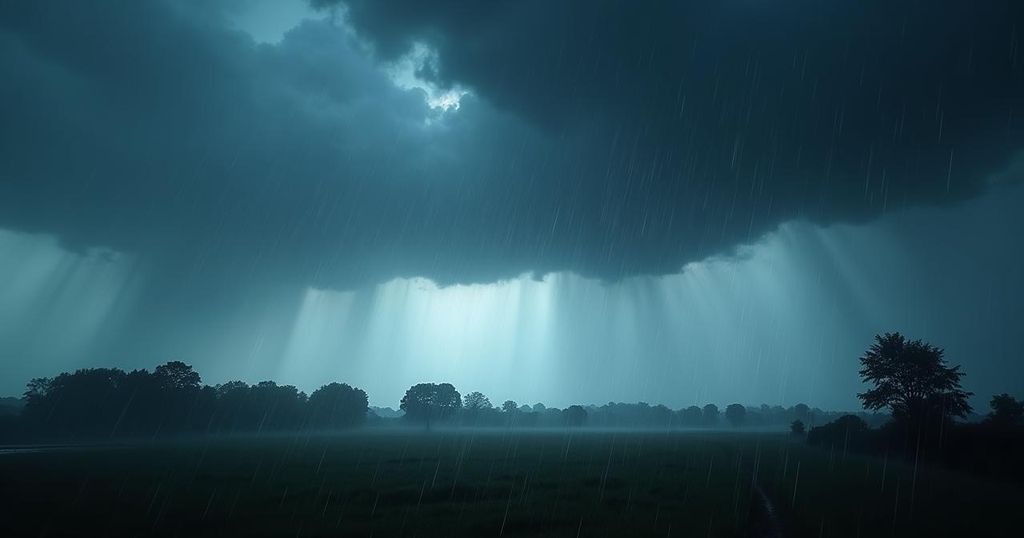Remarkable Rainfall Imposed by Hurricane Helene and Associated Storms
Hurricane Helene and other storms recently resulted in over 40 trillion gallons of rain in the Southeastern U.S., leading to unprecedented flooding and over 100 fatalities. Meteorologists highlighted the record-breaking volume and the changing nature of storms attributed to climate change, noting that the dynamics of multiple storm systems contributed to this extreme weather event.
Recent meteorological data reveals that Hurricane Helene, alongside additional storms, unleashed an astonishing total of over 40 trillion gallons of rain upon the Southeastern United States. This unprecedented volume of water corresponds to the capacity of the Dallas Cowboys’ stadium being filled 51,000 times or filling Lake Tahoe entirely. To visualize this amount of precipitation further, if it were concentrated solely on North Carolina, it would result in depths of 3.5 feet (exceeding 1 meter) of water, capable of filling an estimated 60 million Olympic-sized swimming pools. Such extreme rainfall has prompted significant alarm among experts. Ed Clark, the head of the National Oceanic and Atmospheric Administration’s National Water Center in Tuscaloosa, Alabama, noted, “That is an astronomical amount of precipitation. I have not seen something in my 25 years of working at the weather service that is this geographically large of an extent and the sheer volume of water that fell from the sky.” The severe flooding resulting from this weather phenomenon has had catastrophic effects, claiming over 100 lives according to official reports. Ryan Maue, a private meteorologist and former NOAA chief scientist, employed satellite and ground-based precipitation measurements to calculate approximately 40 trillion gallons of rainfall overall, with 20 trillion of that specifically impacting states such as Georgia, Tennessee, the Carolinas, and Florida from Hurricane Helene alone. Clark corroborated Maue’s calculations, suggesting that the 40 trillion gallon figure is likely an underestimation. In fact, he indicated that this precipitation surpasses twice the combined storage of significant Colorado River reservoirs, including Lake Powell and Lake Mead. Meteorologists attribute this substantial rainfall to a complex interplay of two, potentially three, storm systems. Before Hurricane Helene made landfall, a stagnant low-pressure system had caused heavy rainfall for several days, funneling moisture from the Gulf of Mexico. Concurrently, a less intense storm lingered off North Carolina, contributing up to 20 inches of rain. Helene, being one of the predominant storms in recent decades, added significant amounts of rainfall at elevations ranging from 3,000 to 6,000 feet, forcing water downhill. The mountainous terrain exacerbated the situation, as the storms interacting with the elevations further increased moisture extraction from the atmosphere. North Carolina’s weather officials recorded their highest measurement of 31.33 inches of rainfall in Busick, while Mount Mitchell received over 2 feet. Various meteorological advancements since Hurricane Harvey have shown a disturbing trend toward heavier rainfall events. Clark expressed his concern, stating, “Before 2017’s Hurricane Harvey, I said to our colleagues, you know, I never thought in my career that we would measure rainfall in feet. And after Harvey, Florence, the more isolated events in eastern Kentucky, portions of South Dakota. We’re seeing events year in and year out where we are measuring rainfall in feet. Climate scientists, including Corbosiero and Dello, indicate that storms are becoming increasingly intense as climate change progresses. Research has suggested that a 2 degrees Fahrenheit increase in temperature correlates to a nearly 4% rise in moisture retention in the atmosphere. A preliminary analysis suggested that climate change contributed to approximately 50% more rainfall during Helene in specific regions of Georgia and the Carolinas, lending credence to the idea that human-induced climate change plays a significant role in such weather phenomena. Dello remarked on the distinct characteristics of modern storms, stating, “We’ve seen tropical storm impacts in western North Carolina. But these storms are wetter and these storms are warmer. And there would have been a time when a tropical storm would have been heading toward North Carolina and would have caused some rain and some damage, but not apocalyptic destruction.”
The recent rainfall in the Southeastern United States, attributed to Hurricane Helene and preceding storms, has raised concerns among meteorologists regarding the implications of extreme weather events in connection with climate change. With over 40 trillion gallons of rain falling within a short timeframe, experts are examining the dynamics of multiple storm systems and their impact on hydrology. This incident reflects a growing trend in extreme precipitation, emphasizing the need to understand the influences of climate change on severe weather patterns.
The unprecedented rainfall of over 40 trillion gallons across the Southeast due to Hurricane Helene and associated storms illustrates the escalating severity of weather events likely influenced by climate change. The significant fatalities and damage highlight the urgent need for further research into the connections between storm intensity and climate factors. The findings emphasize a shift in meteorological patterns that could shape the future of weather-related phenomena in the region.
Original Source: abcnews.go.com




Post Comment